Flying, especially commercial aviation, is significantly safer than driving; flyermedia.net emphasizes this, offering a wealth of information on aviation safety and training. While general aviation presents different risks, understanding these risks and implementing safety measures can greatly improve flight safety. Discover insights on aviation safety, pilot training, and risk management at flyermedia.net, focusing on how you can enhance your aviation journey. Whether you’re interested in air travel, flight safety, or the overall aviation industry, resources like accident data, safety regulations, and pilot proficiency can provide a comprehensive view.
1. Is Flying Safer Than Driving? A Comprehensive Analysis
Yes, commercial flying is considerably safer than driving, but the comparison varies greatly depending on the type of flying. In commercial aviation, stringent regulations, advanced technology, and highly trained pilots contribute to an extremely low accident rate. However, general aviation (GA), which includes private planes and personal flights, has a higher accident rate than commercial aviation. Understanding the nuances between different types of flying is crucial when comparing its safety to driving. Let’s delve deeper into the statistics, risk factors, and safety measures associated with both modes of transportation.
2. How Do We Compare Driving and Flying Safety?
Comparing the safety of driving and flying requires understanding the different metrics used to measure accidents and fatalities. National safety agencies use varying methods to report accident rates for air and road travel. The National Highway Traffic Safety Administration (NHTSA) measures accidents per 100 million vehicle miles traveled, while the National Transportation Safety Board (NTSB) measures accidents per 100,000 flight hours.
Here’s a breakdown of the metrics:
- NHTSA: Accidents per 100 million vehicle miles traveled.
- NTSB: Accidents per 100,000 flight hours.
To provide a fair comparison, it’s essential to convert these metrics into a common unit, such as accidents per million hours, to accurately assess the risk associated with each mode of transportation.
3. What Do Statistics Say About Car Accidents?
In 2021, the NHTSA reported over 6.1 million crashes, resulting in 1.37 fatalities per 100 million vehicle miles. Converting this to a rate per million hours driven, a 2020 study indicated approximately 0.6 to 0.7 fatal car crashes per million hours driven. This rate varies depending on the age of the driver, with younger drivers experiencing higher rates (around 1.05) and older drivers experiencing lower rates (around 0.45). According to research from Embry-Riddle Aeronautical University, in July 2025, the likelihood of accidents decreases as driving experience increases. Motorcycling is riskier, with about 16 to 18 fatal motorcycle accidents per million hours ridden, approximately 27 times more frequent than car accidents per vehicle mile.
4. How Does General Aviation Compare to Driving in Terms of Safety?
Overall, general aviation (GA) is more dangerous than driving, but the risk varies depending on the type of GA flight. The NTSB reported 0.95 fatal GA accidents per 100,000 flight hours in 2021, which translates to 9.5 fatal crashes per million flight hours. This is about 14 times the driving fatality rate. However, GA includes various types of flights, such as corporate aviation, personal flights, and instructional flights, each with its own safety profile.
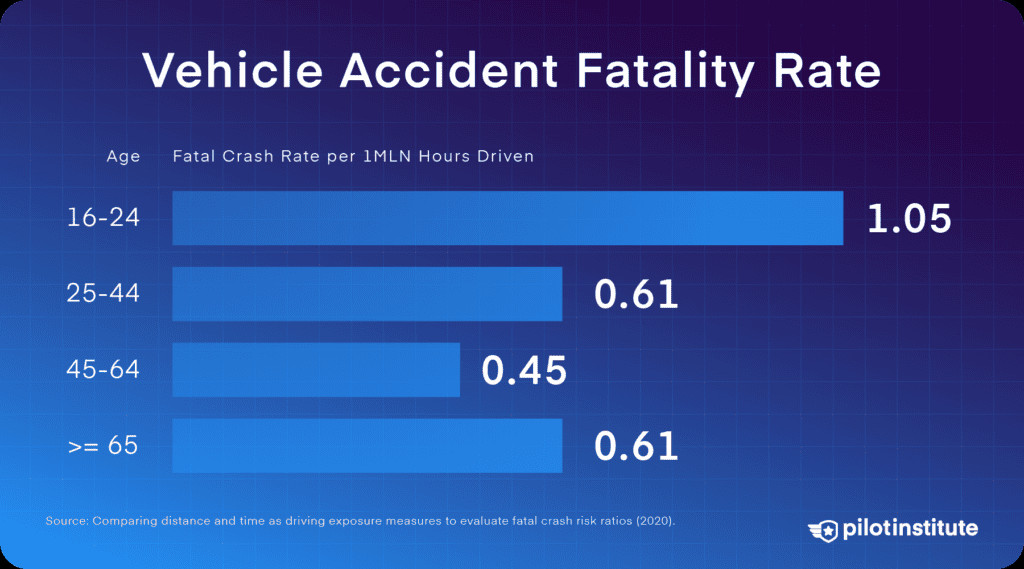 Vehicle accident fatality rate by age
Vehicle accident fatality rate by age
5. How Safe Are Personal Flights Compared to Driving?
Personal flights, which include recreational flying and family trips, are significantly riskier than driving. These flights account for 67% of all GA accidents and 72% of GA fatalities. Between 2012 and 2021, personal flights saw 21.1 fatal accidents per million flight hours, approximately 27 times the driving fatality rate. Therefore, personal GA flights are more dangerous than riding a motorcycle.
6. How Safe Are Instructional Flights Compared to Driving?
Instructional flights are safer than personal flights due to the structured environment, supervised operations, and higher pilot proficiency. Instructional flights saw 2.3 fatal accidents per million flight hours, down 52% since 2012. This means flight training is only about 3.4 times more dangerous than driving. The controlled setting and emphasis on safety protocols in flight training contribute to this lower accident rate.
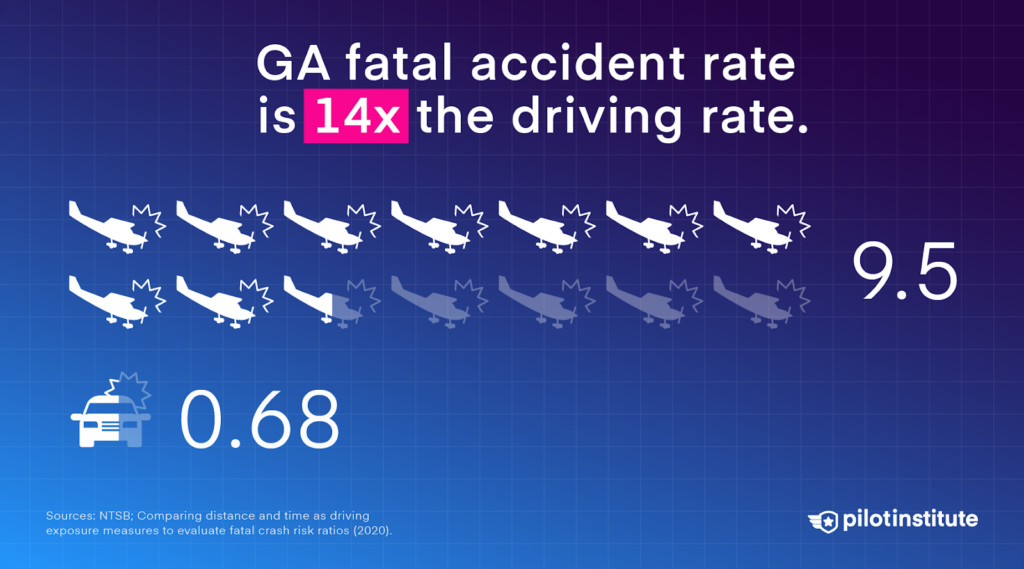 The GA fatal accident rate is roughly 14 times that of driving
The GA fatal accident rate is roughly 14 times that of driving
7. What Are the Primary Risk Factors in General Aviation Accidents?
Risk factors in general aviation accidents can be categorized into pilot-related, mechanical, and other/unknown causes. According to the AOPA’s Richard G. McSpadden Report, pilot error is the leading cause of GA accidents, accounting for 69% of all incidents. Mechanical issues are the second most common cause, comprising about 16% of all accidents. The remaining accidents fall into the other/unknown category, representing 15% of all accidents.
8. What Role Does Pilot Error Play in GA Accidents?
Pilot error is the predominant factor in GA accidents. In 2021, the pilot was deemed at fault in 69% of all GA accidents. The most common defining event is loss of control in-flight (LOC-I), which often results from flying too slow or making uncoordinated and abrupt control inputs. Other significant pilot-related factors include poor decision-making, inadequate flight planning, and failure to adhere to established procedures.
9. What Are the Most Common Mechanical Issues Leading to GA Accidents?
Mechanical failures account for a significant portion of GA accidents, with engine issues being the most prominent. In 2021, there were 57 reported engine failures, but only six resulted in fatalities. Common causes of engine failures include maintenance issues, structural failures, and preventable problems like carb ice or fuel issues. Fuel-related issues, such as fuel contamination, fuel starvation, and fuel exhaustion, also contribute to mechanical accidents.
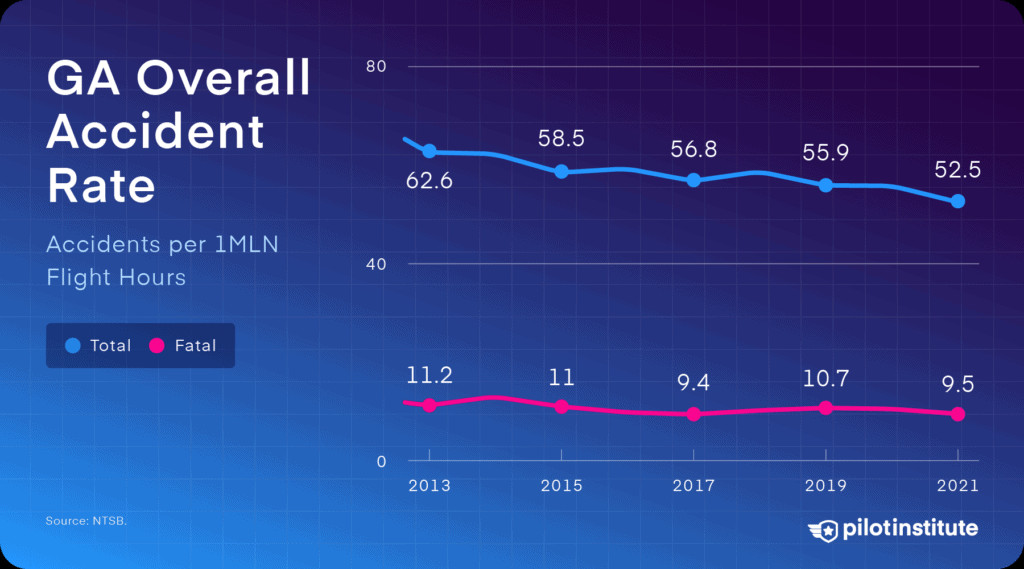 GA overall accident rate: 2012-2021
GA overall accident rate: 2012-2021
10. What is “Loss of Control In-Flight” (LOC-I) and Why Is It So Dangerous?
Loss of control in-flight (LOC-I) occurs when a pilot loses the ability to maintain the desired flight path and attitude of the aircraft. LOC-I is the leading cause of fatal accidents in GA. This can result from various factors, including stalls, spins, turbulence, and uncoordinated control inputs. Half of LOC-I accidents are stalls and spins in the traffic pattern during maneuvering flight, which are seldom recoverable.
11. How Do Weather Conditions Contribute to GA Accidents?
Weather conditions play a significant role in GA accidents, particularly those involving unintended VFR flight into instrument meteorological conditions (IMC). Accidents caused by flying visually into clouds or low visibility had a 71% fatality rate in 2021. Poor IFR technique and icing conditions also contribute to weather-related accidents. Most GA airplanes are not equipped to handle icing conditions or thunderstorms, making it crucial for pilots to avoid flying in adverse weather.
12. What is “Controlled Flight Into Terrain” (CFIT)?
Controlled Flight Into Terrain (CFIT) is an accident in which an aircraft, under the control of the pilot, is unintentionally flown into terrain (ground, mountains, or obstacles). CFIT often results from a total loss of situational awareness or attempts to push below minimums during instrument procedures. It is a leading cause of fatal accidents in GA.
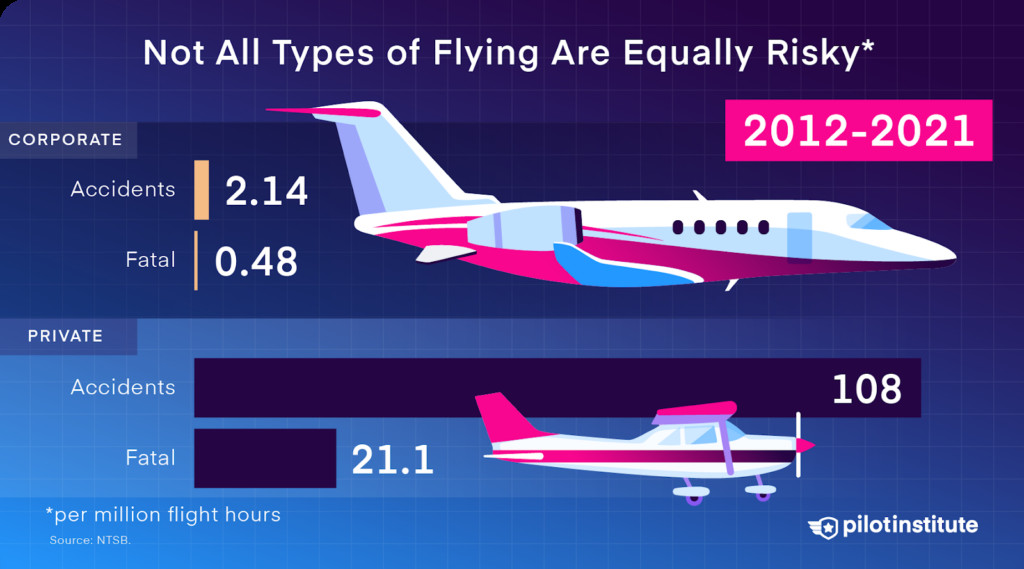 Corporate GA flying is quite safe compared to private flights
Corporate GA flying is quite safe compared to private flights
13. What Safety Measures Can Reduce the Risk in General Aviation?
Several safety measures can reduce the risk in general aviation, including:
- Proficiency: Going above and beyond the legal minimums to maintain a high level of skill and knowledge.
- Structured Operations: Implementing structured procedures and adhering to safety protocols, similar to flight schools and airlines.
- Risk Management: Utilizing risk assessment tools and techniques to identify and mitigate potential hazards.
- Aircraft Maintenance: Ensuring aircraft are maintained to high standards and undergo regular inspections.
- Continuous Learning: Staying updated on the latest safety information and best practices through ongoing training and education.
14. Why Are Instructional Flights Safer Than Personal Flights?
Instructional flights are safer than personal flights due to several key factors:
- Supervised Environment: Flights occur under the supervision of certified flight instructors.
- Structured Operations: Flight schools maintain highly structured operations with a strong emphasis on safety.
- Aircraft Maintenance: Instructional airplanes undergo frequent inspections (every 100 hours) to ensure they are in optimal condition.
- Pilot Proficiency: Flight instructors tend to be more proficient than private pilots who fly less frequently.
15. What Role Does Risk Assessment Play in Aviation Safety?
Risk assessment is a critical component of aviation safety. It involves identifying potential hazards, assessing the likelihood and severity of those hazards, and implementing measures to mitigate the associated risks. Tools like the FAA Risk Assessment Matrix can help pilots evaluate risk factors and make informed decisions about whether to fly. Effective risk management requires a proactive approach and a commitment to safety at all levels of operation.
 Personal flights account for the majority of total GA accidents and fatalities
Personal flights account for the majority of total GA accidents and fatalities
16. How Can Pilots Maintain Proficiency and Reduce Accidents?
Pilots can maintain proficiency and reduce accidents by:
- Regular Flight Training: Engaging in regular flight training to stay current with skills and procedures.
- Proficiency Programs: Participating in proficiency programs offered by aviation organizations.
- Scenario-Based Training: Practicing emergency procedures and challenging scenarios in a controlled environment.
- Mentorship: Seeking guidance and mentorship from experienced pilots.
- Continuous Education: Staying informed about the latest safety information and best practices.
17. What Resources Are Available for Pilots to Improve Safety?
Various resources are available to pilots to improve safety, including:
- Aviation Organizations: Organizations like the AOPA and EAA offer safety programs, training resources, and educational materials.
- FAA Safety Programs: The FAA provides numerous safety programs and resources, including the FAA Safety Team (FAASTeam).
- Online Courses: Online courses and webinars covering various aviation safety topics.
- Flight Simulators: Flight simulators can be used to practice emergency procedures and enhance pilot skills.
- Accident Case Studies: Reviewing accident case studies to learn from past mistakes and prevent future incidents.
18. How Can Aircraft Maintenance Contribute to Aviation Safety?
Proper aircraft maintenance is essential for aviation safety. Regular inspections, timely repairs, and adherence to maintenance schedules can help prevent mechanical failures that could lead to accidents. It’s crucial for aircraft owners and operators to work with qualified mechanics and follow manufacturer recommendations for maintenance.
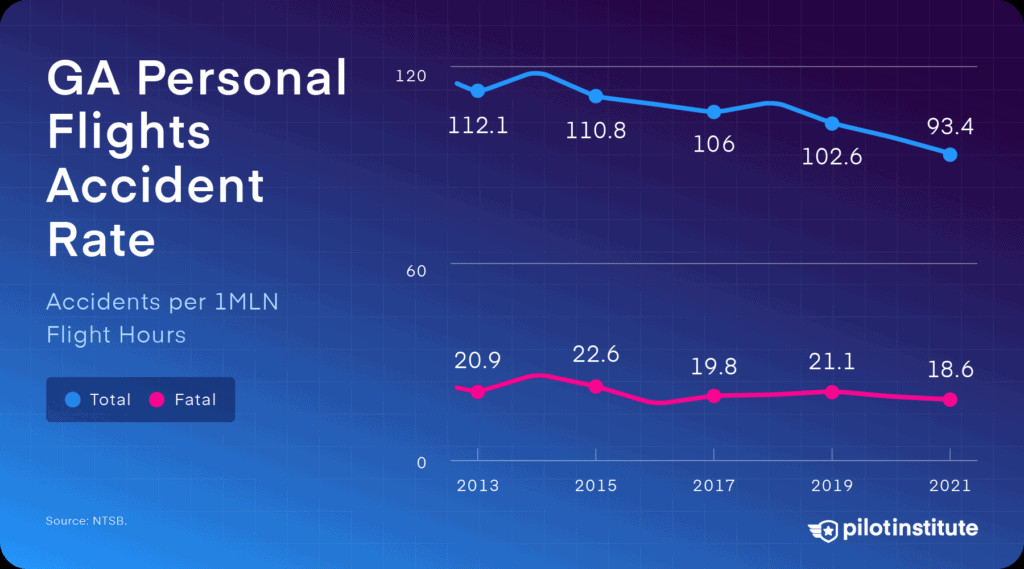 GA personal flights accident rate: 2012-2021
GA personal flights accident rate: 2012-2021
19. What is the Role of Technology in Enhancing Aviation Safety?
Technology plays a significant role in enhancing aviation safety. Advanced avionics, such as GPS navigation systems, autopilot systems, and weather radar, can improve situational awareness and reduce pilot workload. Enhanced Ground Proximity Warning Systems (EGPWS) and Traffic Collision Avoidance Systems (TCAS) can help prevent CFIT and mid-air collisions. Additionally, flight data monitoring systems can be used to identify and address potential safety issues.
20. How Can Flight Planning Reduce Accidents?
Thorough flight planning is crucial for reducing accidents. Proper flight planning involves:
- Weather Briefing: Obtaining a comprehensive weather briefing to assess potential hazards.
- Route Planning: Selecting a safe and efficient route that avoids hazardous terrain and adverse weather conditions.
- Fuel Planning: Calculating fuel requirements and ensuring adequate reserves.
- Performance Calculations: Calculating takeoff and landing performance to ensure sufficient runway length.
- Emergency Planning: Developing a plan for handling potential emergencies, such as engine failures or medical emergencies.
21. What Are the Best Practices for Fuel Management in GA Flights?
Best practices for fuel management in GA flights include:
- Pre-Flight Fuel Check: Checking fuel levels and inspecting for contamination before each flight.
- Fuel Monitoring: Continuously monitoring fuel consumption during flight.
- Fuel Reserve: Maintaining adequate fuel reserves to account for unexpected delays or diversions.
- Fuel System Knowledge: Understanding the aircraft’s fuel system and proper fuel selection procedures.
- Avoiding Fuel Exhaustion: Planning flights carefully to avoid fuel exhaustion.
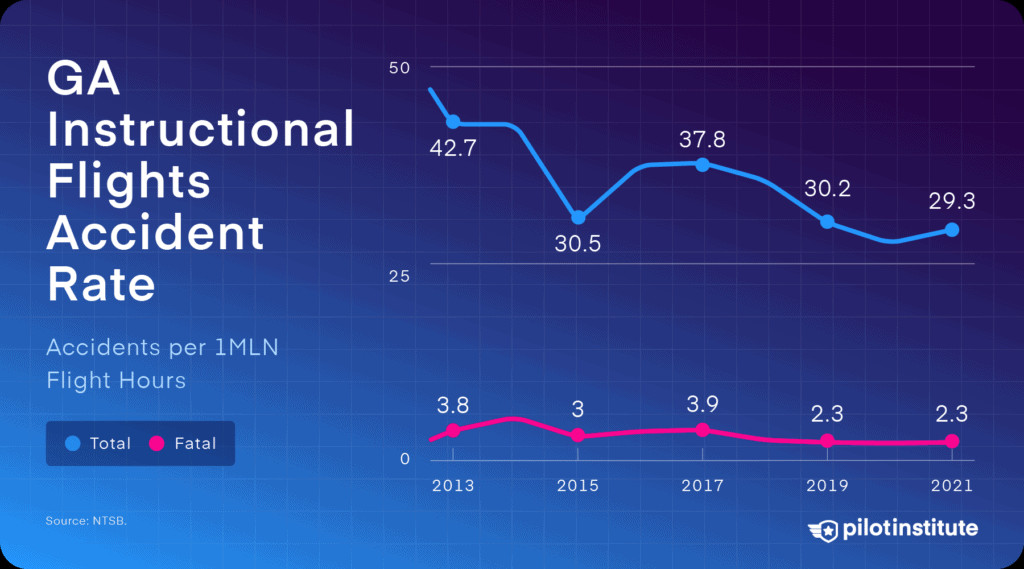 GA instructional flights accident rate: 2012-2021
GA instructional flights accident rate: 2012-2021
22. How Does the FAA Promote Aviation Safety?
The FAA promotes aviation safety through various means, including:
- Regulations: Establishing and enforcing regulations for aircraft operation, maintenance, and pilot training.
- Oversight: Providing oversight of airlines, flight schools, and other aviation organizations.
- Safety Programs: Developing and implementing safety programs, such as the FAA Safety Team (FAASTeam).
- Research: Conducting research to identify and address potential safety issues.
- Education: Providing education and training resources to pilots, mechanics, and other aviation professionals.
23. What Are the Key Elements of a Safety Management System (SMS) in Aviation?
A Safety Management System (SMS) is a structured approach to managing safety risks in aviation. Key elements of an SMS include:
- Safety Policy: A clear statement of the organization’s commitment to safety.
- Safety Risk Management: Processes for identifying, assessing, and mitigating safety risks.
- Safety Assurance: Processes for monitoring and evaluating the effectiveness of safety controls.
- Safety Promotion: Activities to promote a positive safety culture and encourage reporting of safety issues.
24. How Can a Positive Safety Culture Improve Aviation Safety?
A positive safety culture is essential for improving aviation safety. A positive safety culture is one in which:
- Safety is a Priority: Safety is valued above all else.
- Open Communication: People are encouraged to report safety issues without fear of reprisal.
- Continuous Improvement: There is a commitment to learning from mistakes and continuously improving safety performance.
- Accountability: Individuals are held accountable for their actions and decisions.
- Leadership Commitment: Leaders demonstrate a strong commitment to safety.
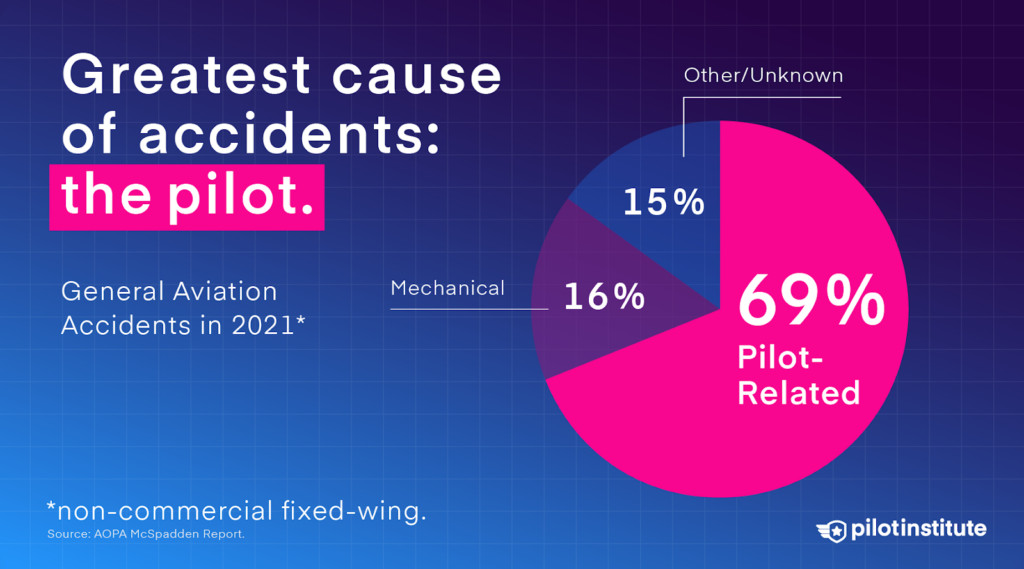 The greatest cause of GA accidents is the pilot
The greatest cause of GA accidents is the pilot
25. What Role Do Human Factors Play in Aviation Accidents?
Human factors play a significant role in aviation accidents. Human factors refer to the psychological, physiological, and social factors that can affect human performance. Some common human factors that contribute to aviation accidents include:
- Fatigue: Reduced alertness and impaired decision-making due to lack of sleep.
- Stress: Increased anxiety and impaired performance due to stress.
- Complacency: Reduced vigilance due to overconfidence or routine tasks.
- Communication Errors: Misunderstandings or lack of communication between crew members.
- Poor Decision-Making: Inadequate assessment of risks and poor judgment.
26. How Can Pilots Mitigate the Risks Associated with Fatigue?
Pilots can mitigate the risks associated with fatigue by:
- Adequate Sleep: Ensuring they get enough sleep before each flight.
- Rest Breaks: Taking regular rest breaks during long flights.
- Caffeine Management: Using caffeine strategically to stay alert.
- Monitoring Fatigue Levels: Monitoring their fatigue levels and making adjustments as needed.
- Avoiding Fatiguing Activities: Avoiding activities that can lead to fatigue, such as long hours of work or strenuous exercise before flying.
27. How Can Pilots Improve Their Decision-Making Skills?
Pilots can improve their decision-making skills by:
- Training: Participating in decision-making training programs.
- Risk Assessment: Conducting thorough risk assessments before each flight.
- Scenario-Based Training: Practicing decision-making in challenging scenarios.
- Mentorship: Seeking guidance from experienced pilots.
- Reviewing Accidents: Reviewing accident case studies to learn from past mistakes.
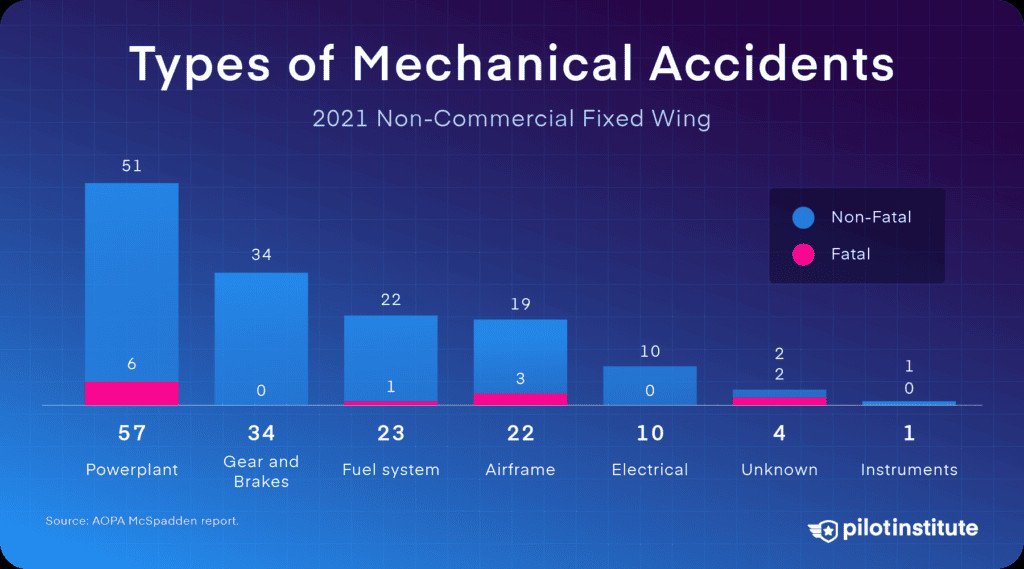 Types of GA mechanical accidents
Types of GA mechanical accidents
28. What Are the Best Practices for Managing Stress in the Cockpit?
Best practices for managing stress in the cockpit include:
- Stress Management Techniques: Practicing stress management techniques, such as deep breathing and visualization.
- Planning and Preparation: Planning flights carefully and being well-prepared for potential challenges.
- Effective Communication: Communicating effectively with crew members and air traffic control.
- Situational Awareness: Maintaining situational awareness and anticipating potential problems.
- Knowing Your Limits: Recognizing your limits and avoiding situations that could lead to excessive stress.
29. How Can Pilots Prevent Complacency from Affecting Their Performance?
Pilots can prevent complacency from affecting their performance by:
- Staying Vigilant: Maintaining a high level of vigilance and attention to detail.
- Challenging Assumptions: Questioning assumptions and verifying information.
- Varying Routines: Varying routines to avoid becoming complacent.
- Seeking Feedback: Seeking feedback from other pilots and instructors.
- Continuous Learning: Continuously learning and staying updated on the latest safety information.
30. What Role Does Communication Play in Aviation Safety?
Effective communication is essential for aviation safety. Clear and concise communication between crew members, air traffic control, and other stakeholders can help prevent misunderstandings and errors. It’s crucial for pilots to use standard phraseology and follow established communication protocols.
31. How Can Pilots Improve Communication in the Cockpit?
Pilots can improve communication in the cockpit by:
- Using Standard Phraseology: Using standard phraseology and following established communication protocols.
- Active Listening: Practicing active listening and confirming understanding.
- Clear and Concise Communication: Communicating clearly and concisely.
- Crew Resource Management (CRM): Utilizing CRM principles to promote effective teamwork and communication.
- Briefings and Debriefings: Conducting thorough briefings before flights and debriefings after flights to discuss any issues or lessons learned.
 Six out of 57 engine failure accidents in 2021 were fatal
Six out of 57 engine failure accidents in 2021 were fatal
32. How Can Crew Resource Management (CRM) Enhance Aviation Safety?
Crew Resource Management (CRM) is a system that promotes effective teamwork and communication in the cockpit. CRM training helps pilots and other crew members work together more effectively, communicate clearly, and make better decisions. Key elements of CRM include:
- Communication: Clear and concise communication between crew members.
- Teamwork: Working together as a team to achieve common goals.
- Situational Awareness: Maintaining situational awareness and anticipating potential problems.
- Decision-Making: Making sound decisions based on available information.
- Leadership: Effective leadership that promotes safety and teamwork.
33. What Are the Benefits of Using Checklists in Aviation?
Checklists are essential tools for ensuring that critical tasks are performed correctly in aviation. The benefits of using checklists include:
- Reduced Errors: Checklists help reduce errors by ensuring that important steps are not overlooked.
- Improved Consistency: Checklists promote consistency in procedures and reduce variability.
- Enhanced Memory: Checklists serve as a memory aid and help pilots remember important tasks.
- Standardization: Checklists standardize procedures and promote consistency across different pilots and aircraft.
- Verification: Checklists provide a means of verifying that tasks have been completed correctly.
34. How Can Pilots Use Checklists Effectively?
Pilots can use checklists effectively by:
- Following Checklists Carefully: Following checklists carefully and not skipping steps.
- Using Standard Checklists: Using standard checklists that are approved for the aircraft.
- Customizing Checklists: Customizing checklists to meet the specific needs of the flight.
- Practicing with Checklists: Practicing with checklists regularly to become familiar with their content and format.
- Verifying Completion: Verifying that each step has been completed correctly before moving on to the next step.
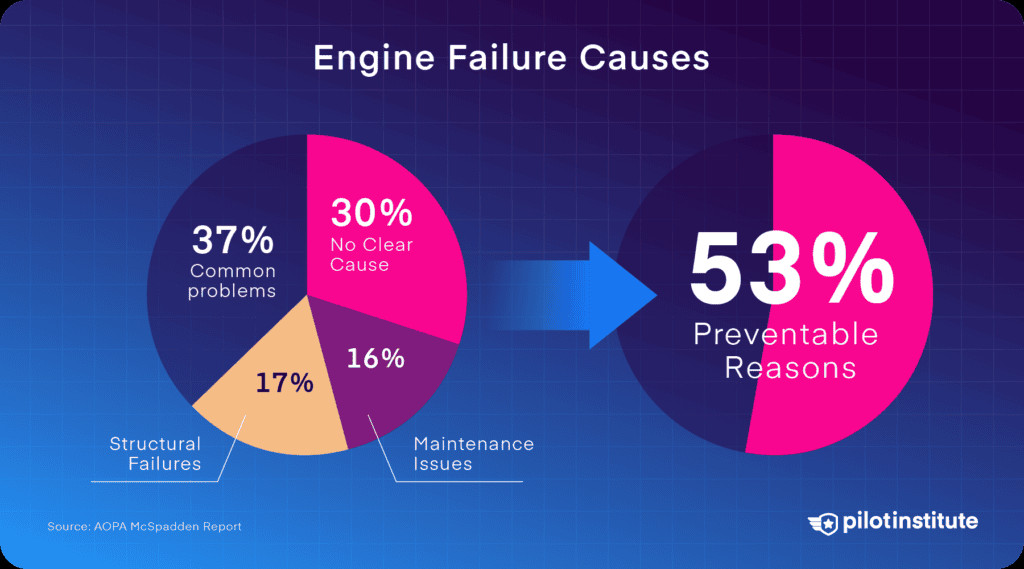 A diagram depicting the reasons for engine failures
A diagram depicting the reasons for engine failures
35. How Can Pilots Prepare for Emergency Situations?
Pilots can prepare for emergency situations by:
- Emergency Procedures Training: Participating in emergency procedures training to learn how to handle various emergencies.
- Scenario-Based Training: Practicing emergency procedures in realistic scenarios.
- Reviewing Emergency Procedures: Reviewing emergency procedures regularly to stay familiar with them.
- Using Simulators: Using simulators to practice emergency procedures in a safe and controlled environment.
- Planning for Emergencies: Planning for potential emergencies before each flight.
36. What Are the Best Practices for Responding to Engine Failures?
Best practices for responding to engine failures include:
- Maintaining Control: Maintaining control of the aircraft.
- Troubleshooting: Attempting to troubleshoot the engine failure.
- Declaring an Emergency: Declaring an emergency with air traffic control.
- Selecting a Landing Site: Selecting a suitable landing site.
- Following Emergency Procedures: Following emergency procedures for engine failures.
37. How Can Pilots Improve Their Situational Awareness?
Pilots can improve their situational awareness by:
- Planning and Preparation: Planning flights carefully and being well-prepared for potential challenges.
- Monitoring Instruments: Monitoring instruments regularly to stay informed about the aircraft’s performance.
- Scanning the Environment: Scanning the environment to identify potential hazards.
- Communicating with Crew Members: Communicating effectively with crew members.
- Using Technology: Using technology, such as GPS and weather radar, to enhance situational awareness.
 Types of GA fuel management accidents
Types of GA fuel management accidents
38. How Can Pilots Avoid Flying into Instrument Meteorological Conditions (IMC) Unintentionally?
Pilots can avoid flying into Instrument Meteorological Conditions (IMC) unintentionally by:
- Weather Briefing: Obtaining a comprehensive weather briefing before each flight.
- Monitoring Weather: Monitoring weather conditions during flight.
- Avoiding Marginal Weather: Avoiding flying in marginal weather conditions.
- Turning Back: Turning back if weather conditions deteriorate.
- Instrument Proficiency: Maintaining instrument proficiency.
39. What Are the Best Practices for Flying in Instrument Meteorological Conditions (IMC)?
Best practices for flying in Instrument Meteorological Conditions (IMC) include:
- Instrument Proficiency: Maintaining instrument proficiency.
- Using Instruments: Relying on instruments for navigation and control.
- Following Procedures: Following established procedures for instrument flight.
- Communicating with Air Traffic Control: Communicating effectively with air traffic control.
- Avoiding Hazardous Weather: Avoiding hazardous weather conditions, such as icing and thunderstorms.
40. How Can Pilots Avoid Controlled Flight Into Terrain (CFIT) Accidents?
Pilots can avoid Controlled Flight Into Terrain (CFIT) accidents by:
- Situational Awareness: Maintaining situational awareness.
- Using Terrain Awareness Systems: Using terrain awareness systems, such as Enhanced Ground Proximity Warning Systems (EGPWS).
- Following Procedures: Following established procedures for instrument flight.
- Avoiding Hazardous Terrain: Avoiding flying over hazardous terrain.
- Maintaining Altitude: Maintaining safe altitudes.
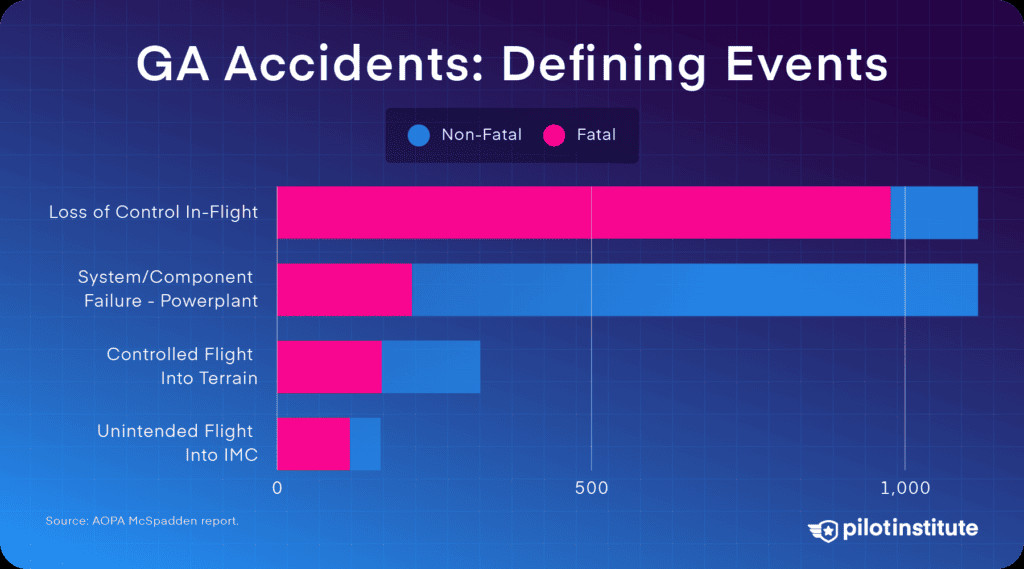 A selection of GA accident defining events
A selection of GA accident defining events
41. How Can Pilots Manage the Risks Associated with Night Flying?
Pilots can manage the risks associated with night flying by:
- Night Flying Training: Obtaining night flying training.
- Using Night Vision: Using night vision equipment, such as night vision goggles (NVGs).
- Maintaining Situational Awareness: Maintaining situational awareness.
- Avoiding Hazardous Terrain: Avoiding flying over hazardous terrain.
- Using Instruments: Relying on instruments for navigation and control.
42. What Are the Best Practices for Flying in Mountainous Terrain?
Best practices for flying in mountainous terrain include:
- Mountain Flying Training: Obtaining mountain flying training.
- Planning and Preparation: Planning flights carefully and being well-prepared for potential challenges.
- Using Charts and Maps: Using charts and maps to identify terrain features.
- Maintaining Altitude: Maintaining safe altitudes.
- Avoiding Downdrafts: Avoiding areas where downdrafts are likely to occur.
43. How Can Pilots Manage the Risks Associated with Turbulence?
Pilots can manage the risks associated with turbulence by:
- Weather Briefing: Obtaining a comprehensive weather briefing before each flight.
- Turbulence Forecasts: Reviewing turbulence forecasts.
- Avoiding Turbulence: Avoiding areas where turbulence is likely to occur.
- Bracing for Turbulence: Bracing for turbulence when it is encountered.
- Slowing Down: Slowing down the aircraft to reduce the impact of turbulence.
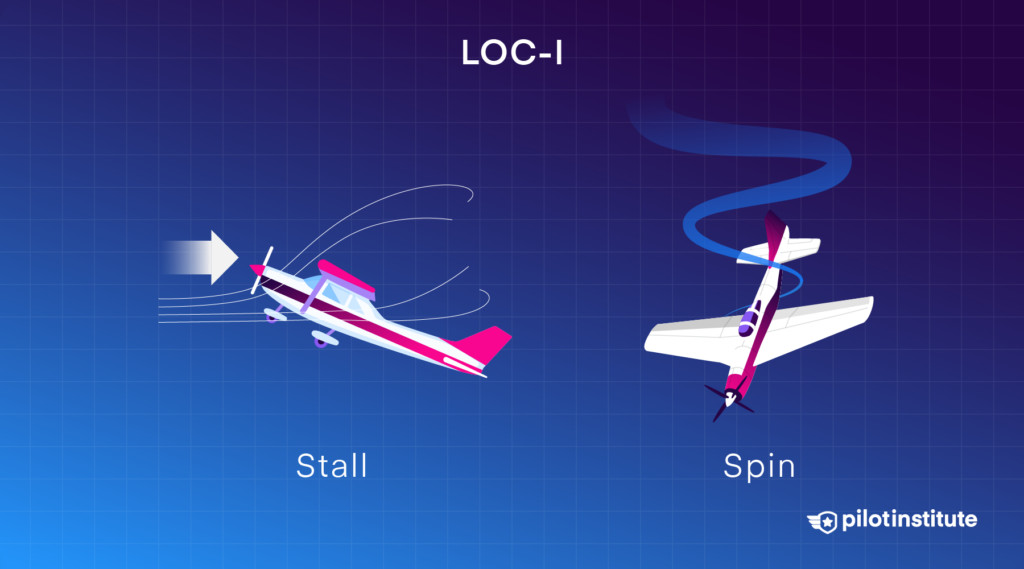 Loss of Control In-Flight: the leading cause of fatal accidents
Loss of Control In-Flight: the leading cause of fatal accidents
44. What Are the Best Practices for Managing Icing Conditions?
Best practices for managing icing conditions include:
- Avoiding Icing: Avoiding flying in icing conditions.
- De-Icing Equipment: Using de-icing equipment, such as de-icing boots.
- Anti-Icing Equipment: Using anti-icing equipment, such as heated wings and propellers.
- Monitoring Icing: Monitoring the aircraft for signs of icing.
- Changing Altitude: Changing altitude to avoid icing conditions.
45. How Can Pilots Stay Updated on the Latest Safety Information and Best Practices?
Pilots can stay updated on the latest safety information and best practices by:
- Attending Safety Seminars: Attending safety seminars and workshops.
- Reading Aviation Publications: Reading aviation publications, such as FAA Safety Briefing and AOPA Pilot.
- Participating in Online Forums: Participating in online forums and discussion groups.
- Following Aviation Organizations: Following aviation organizations on social media.
- Reviewing Accident Reports: Reviewing accident reports and learning from past mistakes.
46. How Can Aviation Organizations Promote Safety in the Aviation Community?
Aviation organizations can promote safety in the aviation community by:
- Providing Safety Training: Providing safety training and education programs.
- Developing Safety Resources: Developing safety resources, such as checklists and manuals.
- Conducting Safety Audits: Conducting safety audits and inspections.
- Promoting Safety Culture: Promoting a positive safety culture.
- Sharing Safety Information: Sharing safety information and best practices.
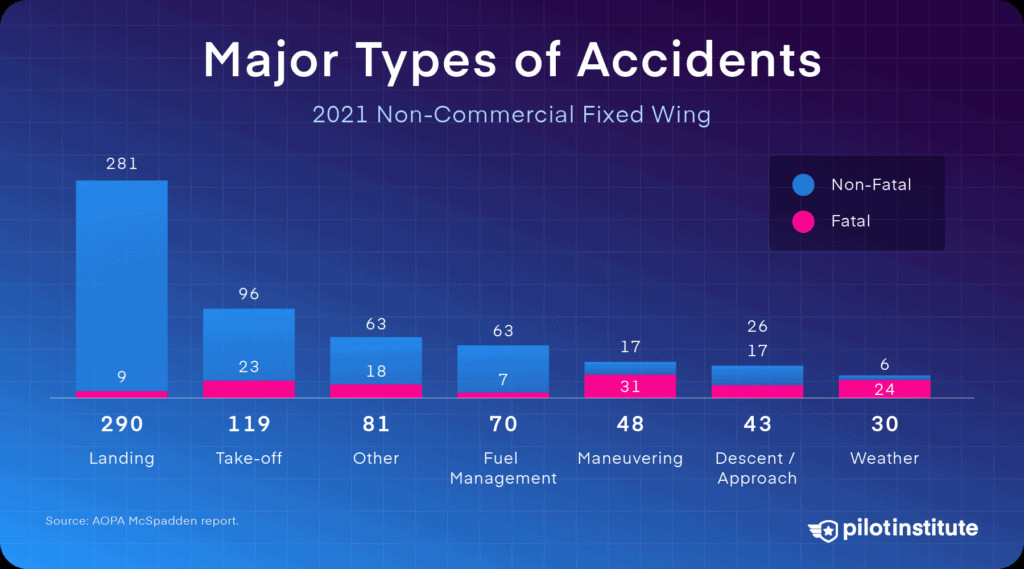 Major types of GA accidents
Major types of GA accidents
47. What Role Do Flight Simulators Play in Aviation Safety?
Flight simulators play a significant role in aviation safety by:
- Providing Realistic Training: Providing realistic training in a safe and controlled environment.
- Practicing Emergency Procedures: Practicing emergency procedures without the risk of injury or damage to the aircraft.
- Enhancing Skills: Enhancing pilot skills and decision-making abilities.
- Reducing Training Costs: Reducing training costs compared to actual flight training.
- Evaluating Pilot Performance: Evaluating pilot performance and identifying areas for improvement.
48. How Can Pilots Use Flight Simulators Effectively?
Pilots can use flight simulators effectively by:
- Setting Realistic Scenarios: Setting realistic scenarios that replicate actual flight conditions.
- Practicing Emergency Procedures: Practicing emergency procedures regularly.
- Debriefing After Simulations: Debriefing after simulations to discuss lessons learned.
- Seeking Feedback: Seeking feedback from instructors and other pilots.
- Using Simulators Regularly: Using simulators regularly to maintain skills and proficiency.
49. How Can the Aviation Community Learn from Accident Investigations?
The aviation community can learn from accident investigations by:
- Reviewing Accident Reports: Reviewing accident reports and understanding the causes of accidents.
- Identifying Lessons Learned: Identifying lessons learned from accidents.
- Sharing Information: Sharing information about accidents and lessons learned with the aviation community.
- Implementing Safety Recommendations: Implementing safety recommendations from accident investigations.
- Preventing Future Accidents: Using lessons learned from accidents to prevent future accidents.
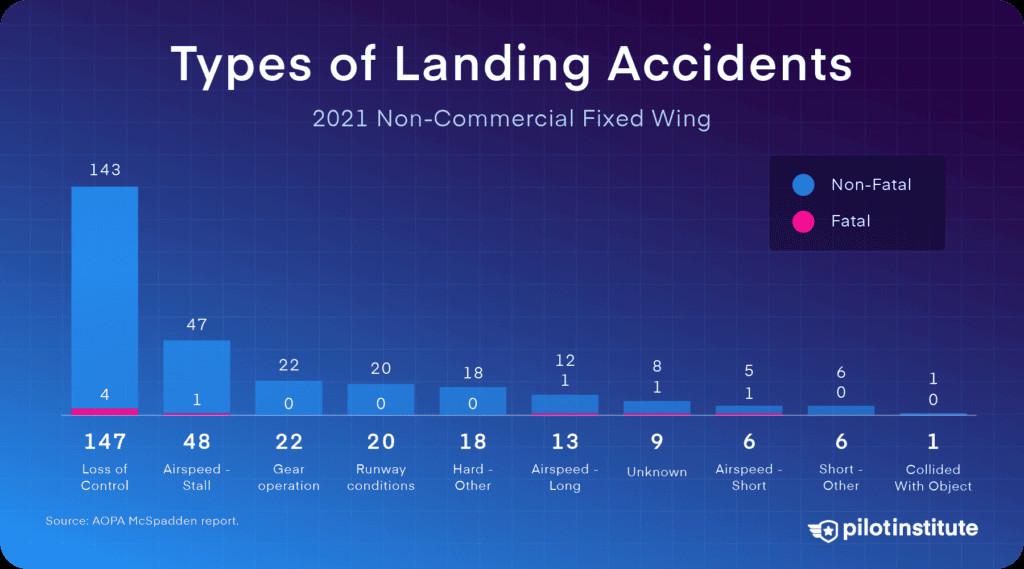 Types of GA landing accidents
Types of GA landing accidents
50. What Is the Future of Aviation Safety?
The future of aviation safety is likely to be shaped by:
- Technological Advancements: Technological advancements, such as automation and artificial intelligence.
- Data Analysis: Data analysis and predictive modeling.
- Improved Training: Improved training and education programs.
- Enhanced Communication: Enhanced communication and collaboration.
- Proactive Safety Measures: Proactive safety measures to prevent accidents before they occur.
In conclusion, while commercial flying remains significantly safer than driving due to stringent regulations and advanced technology, general aviation presents unique risks that require careful management. By understanding these risks, implementing safety measures, and continuously improving skills and knowledge, pilots can reduce the likelihood of accidents and enjoy the freedom of flight safely. For more information on aviation safety, pilot training, and career opportunities, visit flyermedia.net. Whether you’re seeking flight training, aviation news, or career guidance, flyermedia.net is your go-to resource for all things aviation.
FAQ Section
1. How Many Times Safer Is Flying Than Driving on average?
Commercial flying is, on average, many times safer than driving, with significantly lower accident and fatality rates per mile traveled.
2. Is general aviation as safe as commercial flying?
No, general aviation is not as safe as commercial flying, with higher accident rates due to less stringent regulations and varied pilot experience.
3. What are the main reasons for accidents in general aviation?
Pilot error, mechanical failures, and weather conditions are the main reasons for accidents in general aviation.
4. How can pilots improve safety in general aviation flights?
Pilots can improve safety by maintaining proficiency, adhering to safety protocols, and conducting thorough pre-flight checks.
5. What role does technology play in improving aviation safety?
Technology enhances aviation safety through advanced avionics, weather monitoring systems, and automated flight controls.
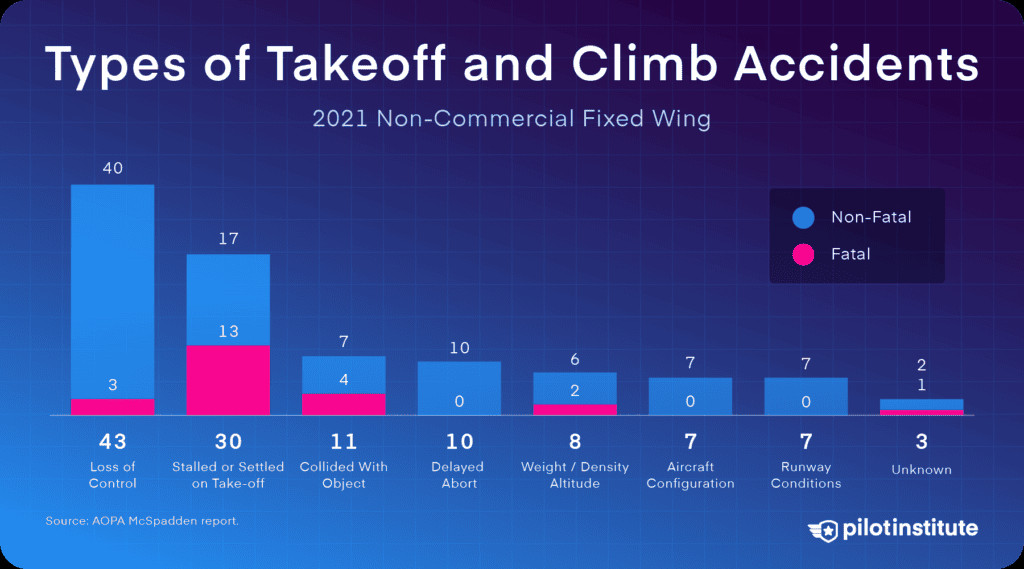 Types of GA takeoff and climb accidents
Types of GA takeoff and climb accidents
6. What is the FAA’s role in ensuring aviation safety?
The FAA sets regulations, provides oversight, and offers resources to ensure aviation safety across all sectors.
7. How does weather impact the safety of general aviation flights?
Adverse weather conditions, such as icing, turbulence, and low visibility, significantly increase the risk of accidents in general aviation.
8. What are the key elements of a Safety Management System (SMS) in aviation?
Key elements include safety policy, risk management, safety assurance, and safety promotion to create a culture of safety.
9. Why is continuous training important for pilots?
Continuous training ensures pilots stay updated on best practices, maintain proficiency, and adapt to new technologies.
10. Where can I find more information on aviation safety and pilot training?
Visit flyermedia.net for comprehensive information on aviation safety, pilot training programs, and career opportunities in the aviation industry, or visit Address: 600 S Clyde Morris Blvd, Daytona Beach, FL 32114, United States or Phone: +1 (386) 226-6000.
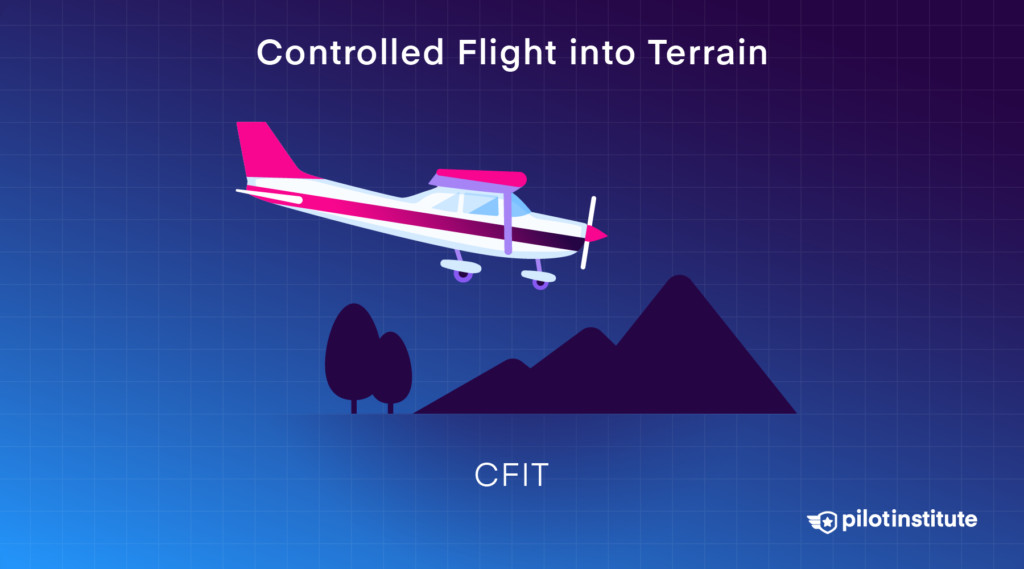 Controlled Flight into Terrain: a top cause of fatal accidents
Controlled Flight into Terrain: a top cause of fatal accidents
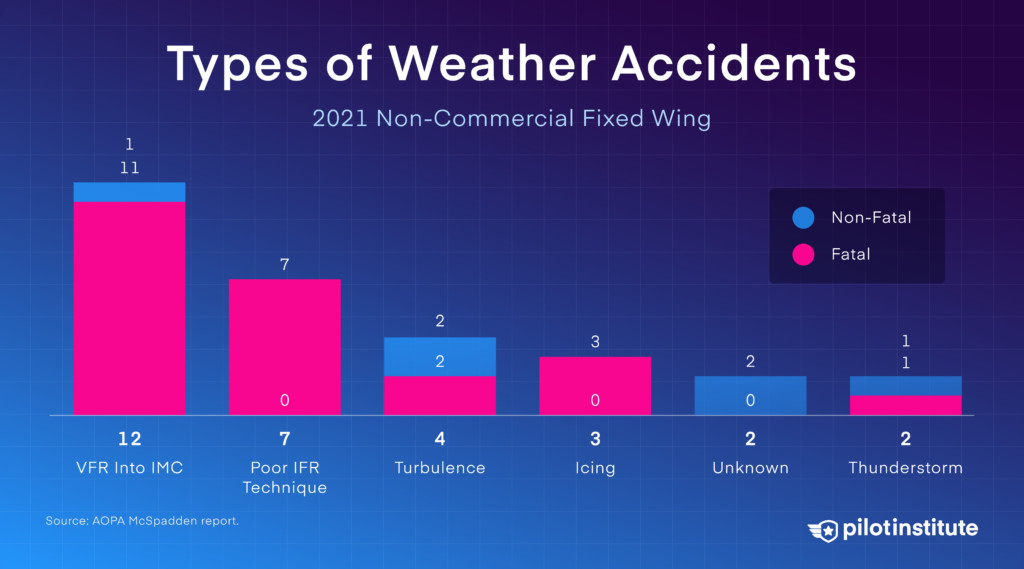 Types of GA weather accidents
Types of GA weather accidents